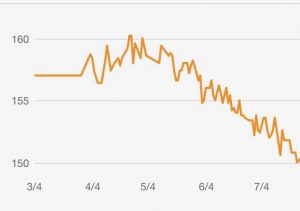Several of my clients have asked me about Intermittent Fasting (I.F.) and heard that it works when shedding unwanted weight and body fat. Proponents claim that it is an easy diet to follow, that anybody can do it, and that it is a sustainable lifestyle. I think you find my 60-day experiment with intermittent fasting helpful and enlightening.
In my thirty years as a trainer, ultra marathon runner, triathlete, and former bodybuilder, I have tried nearly every diet and nutrition protocol to see if they work. Each time a diet comes on the market, I get asked the same question, “Does this actually work, and what do you think of it?”
I was curious to hear all about it. So what better way than to try it and log my findings for you to decide whether I.F. is for you?
My friends at Precision Nutrition helped me with some background information for this blog on I.F., and I took it from there.
I’ve been in menopause for the past 7 years and struggle with belly fat like many women my age. It can be a significant problem and challenging to get rid of during this stage of life. I wanted to find out if I.F. would solve the problem of excess weight gain for our age group. I had no specific weight number in mind when I started, but after a challenging year of surgery, weight gain, and a foot injury that kept me from my normal activities, I felt flabby and out of shape.
My 60-day Intermittent Fasting Experience
What I Learned – The Short List
- Was it as easy as many people claim? No
- Did I lose weight? Yes
- Is it for everybody? No
For years, I have told my clients to eat every 3-4 hours, combining it with healthy food choices and a consistent exercise program. This approach has helped my clients achieve their weight loss and fitness goals.
People who advocate for I.F. say that the better way to eat is not every 4 hours but within a specific time frame. However, it should be noted that research into the I.F. diet is still in its infancy, and the long-term data showing its effects are unclear.
What Did I Test?
First, I learned about the I.F. protocols that are currently circulating and then tailored the routine I would follow to my lifestyle. Basically, I created my own I.F. protocol because I did not want it to feel like I was starting a diet. Instead, I wanted to create a routine that could potentially be a sustainable lifestyle change.

- I kept meticulous records of everything from my weight on the scale, energy levels, my grumpy factor, precisely what I ate, and what type of exercises I did.
- I wanted to see if I could lose weight with I.F. despite menopausal hormone fluctuations.
What Happened Over The Course Of Two Months?
By creating my I.F. routine that I didn’t think was restrictive, I found I was hitting my targets with less worry about a traditional diet and exercise program.
So what were my final results? My weight dropped from 159 to 150 pounds.
You have to be willing to feel hungry. Intermittent Fasting is NOT easy, and it’s not for everyone (neither does it have to be).
Comparing Some Of The Popular Intermittent Fasting Programs
Before I get into how I did it, I want to show you what popular I.F. protocols are available. I.F. sounds so very promising, but when it gets to the part of actually doing it, it becomes a bit muddled.
How many days or hours should you fast? How much should you eat? Should you eat the same food the day before and after the fast? There is no clear answer to those questions, and proponents of I.F. have come up with their best guesses.
- Alternate Day Fasting: 36-hours fast, 12-hours feed. Here you eat every other day and are allowed to eat anything during your feeding period.
- Meal Skipping: You skip meals once or twice a week and are encouraged to eat unprocessed foods
- Eat Stop Eat: 24-hour fast, 1-2 times per week.
- Leangains: 16-hour fast, 8-hour feed. You’re encouraged to eat foods high in protein, cycle carbohydrates, and exercise in a fasted state.
- Warrior Diet: 20-hour fast, 4-hour feed. You can eat small amounts of specifically recommended foods during your fast and feed in the other 4 hours.
How Did My Intermittent Fasting Experience Go?
None of the IF protocols sounded appealing. I was unwilling to eat, limit, or randomly eat for a day. So I tweaked the approach, so it might just work for me.
I usually eat 3 meals plus two snacks daily, primarily high protein, lots of vegetables, some starches, and some wine. I drink at least 1 gallon of water daily and exercise 5-6 days weekly.
I used calculator.net to determine my daily calorie intake with a goal weight loss of 1 pound per week at 1650 calories. I had no specific weight loss goal in mind, but just like with any fitness and wellness program, you want to set goals. Then I dialed my macronutrients into 30% Carbohydrates, 45% Protein, and 25% Fat.
Due to my foot injury, my cardiovascular workouts mainly consisted of swimming and walking two times per week and strength training or Pilates 3 times each week for 30 minutes.
When I started, the only thing I changed was taking out the snacks I had each day, a 300-calorie reduction.
I logged my workouts on my wearable and my food intake on MyFitnessPal. I can sync both apps and see what I ate and burned calories.
What I Ate During That Time
I did not follow a specific meal plan. I wanted to feel free to eat anything, and I didn’t want to feel as if I would “blow” my diet by going out with my friends during my 60-day experiment. That being said, I do have a healthy meal routine that I tend to follow.

Sample Day Meal:
Breakfast – Super shake (1 handful spinach, 1 scoop protein powder, 1 cup milk/alt milk, 1 tbsp. Chia seeds, ½ banana)
Lunch – Sandwich (1 slice multigrain bread, ½ apple, ¼ avocado, 2-3 oz turkey, 1 cup broccoli, potatoes, or various vegetables)
Dinner – 6 oz chicken and a salad (2 cups mixed lettuce, ½ diced carrot, ½ diced red pepper, 2 diced tomatoes, 2 large mushrooms, light mustard vinaigrette)
Dessert – Skinny Cow caramel cone
2 nights a week, I’d have 2 glasses of wine.
Meal Frequency:
3 meals per day, with a 5-6 hour fasting window until the next meal.
Supplements:
5000 IU Vitamin D
2000 I.U. Vitamin K
15 ml (1 capsule) fish oil
So How Did Things Work Out For Me?
During the first two weeks on I.F., I was ravenous and could not wait to eat. I was not used to feeling this hungry and drinking 2 to 3 glasses of water before each meal to curb my appetite. I was constipated the first week and then bloated for a few days.
I did not lose any weight in the first week. My weight tended to go up 1-1.5 pounds before I would lose 1 pound. I charted my weight below, showing a clear downward trend. I kept my “key day” for my weigh-ins on Mondays.

Anyone’s weight fluctuates through any given week (and during every day); this is normal. Expect your weight to go up and down. Weight gain is not body fat if you’re staying within your macronutrients. It’s water weight. Trust your critical day weight; if it’s progressively decreasing over time, you are on the right track.
After a month on my I.F. plan, I stopped losing weight. I started getting constipated again, followed by bloating, but then I started feeling cold when I got closer to mealtime. Again this stopped after about a week, and my body settled into the new routine.
Mood And Energy
I felt irritated and restless during the day in the first two weeks. I slept well during the entire time of my I.F. experiment. One day I mowed the lawn to do something because I missed my regular cardio workouts. I was glad not to have to train for a triathlon because I could not complete my training while on intermittent fasting.
I don’t think it’s the magic bullet to weight loss, but it could work for some struggling to lose weight. You have to be able to tolerate hunger and fatigue during that time. I don’t see it as a lifestyle change but a reality check into your relationship with food.

Thanks for being a test subject 🙂 Very interesting… I wondered about IF. As a holistic nutritionist-in-training, I am most concerned with lifestyle change that is long-term and sustainable. I can see that if someone was at risk for or suffering from a chronic lifestyle disease, they may need to take some immediate action and IF might make sense. But, yeah, may not be for all people. I know I get into trouble when I get too hungry and grumpy 😉
You are welcome 🙂 your concern is very valid I agree. The grumpy factor is something to consider if it’s worth it or not. Thank you.
Comments are closed.